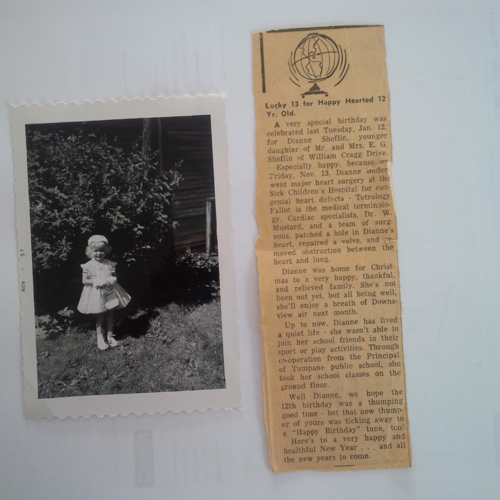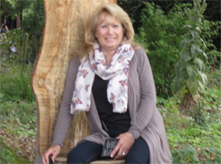
After her first open-heart surgery in 1964, Dianne Sheflin-Armstrong’s story was featured in a local Toronto paper (right). Young Dianne (pictured left) was lucky to have survived so long with her heart defect. (Credit: Dianne Sheflin-Armstrong)
For Dianne Sheflin-Armstrong's parents, the first hint at a lifetime of uncertainty came when she was born with blue-tinted skin.
"The doctors informed my parents that I wouldn't live past the age of three."
Now 62 years old, Armstrong looks back on living with Tetralogy of Fallot, a heart defect that limits the amount of oxygen in the blood.
"I never thought I would live to have two children, to have grandchildren and to be 42 years married," she says, elated.
Understanding Tetralogy of Fallot
Today, a child born with Tetralogy of Fallot has a surgical repair within the first year of life. But in 1953, when Armstrong was born, it was risky to perform open-heart surgery. Only a few simple congenital heart defects could be repaired, but surgical repair of Tetralogy of Fallot was not available in 1953; the first repair was performed in 1954.
"Armstrong represents a typical generation of patients with Tetralogy of Fallot," says Dr. Erwin Oechslin, Director of the Adult Congenital Heart Disease Program and Bitove Family Professor of Adult Congenital Heart Disease at the Peter Munk Cardiac Centre. "For those born in the early 40s or 50s, there was no surgical option to repair the defect. Many of our adult patients (e.g. with Tetralogy of Fallot) were operated on at the ages of 10, 15 or even 20 --- if they could survive."
Less than one per cent of babies are born with this heart defect, Dr. Oechslin explains. The condition is comprised of four elements, including the Overriding Aorta (the aorta is in the wrong spot), a ventricular septal defect (communication between the right and left ventricle), narrowing of the outflow to the pulmonary artery and Right Ventricular Hypertrophy (thickened heart muscle). They all conspire to produce low oxygen levels in the blood.
Low oxygen means cyanosis (bluish discoloration of the skin), and low energy for patients with Tetralogy of Fallot.
"If the blood mixture [contained] too much carbon dioxide I would get these weak spells (known as 'blue spells') where I would feel dizzy and like I was going to pass out," Armstrong says. "I would just squat, up against a wall or just anywhere. I got very good at just squatting."
According to Dr. Oechslin, before comprehensive surgical procedures were available, only 20 per cent of patients with Tetralogy of Fallot would survive. Now, the survival rate is more than 95 per cent.
Living with the blues
Even walking made Armstrong feel exhausted.
"My dad carried me pretty well everywhere. I remember going through Niagara Falls being piggy-backed by my dad. He took me down through the tunnels just so I could see the tunnels of Niagara Falls."
Every day, her mother drove her to school, where a caretaker was responsible for carrying her to her desk and then back to the car after class.
Heroic decisions
An intense weak spell in mid-November of 1964 led to Armstrong's first open-heart surgery when she was 12 years old.
"I had collapsed in the hallway after a bath," Armstrong recalls. "My parents took me down to SickKids, and the doctor told my parents he had to do the surgery within 48 hours or I would not survive. I had a 40 per cent chance of survival on the table."
The surgery was booked for Friday the 13th – an unlucky omen in Armstrong's mother's eyes.
"She was so afraid," Armstrong says. "My mum cried literally the whole night."
Often, parents and patients are forgotten in these tales of survival, Dr. Oechslin says.
"These were heroic decisions being made by the parents," he explains. "Should I just accept the natural history for my daughter or should I agree to do a risky surgical procedure for my daughter?"
"If it wasn't for my parents, I wouldn't be here," Armstrong says.
After nine hours of surgery, she was wheeled out. "I could see all the lights going by me from my bed. My doctor leaned his head toward me and said, 'Dianne, you're going to be alright now.'"

Over 40 years after her first open-heart surgery, Dianne lives a happy, healthy life as a mother and a wife. (Photo: Dianne Armstrong)
Life after surgery
"Back in those days, cardiac rehabilitation just meant that you didn't do anything. I spent a year at home – I had missed my whole year of grade six," Armstrong says. "My parents asked what would be the best way for me to gain my strength and they said swimming. So my dad had an in-ground pool put into our backyard for me to swim during the summer."
She recovered gradually. "I started to gain weight, but I was still always small. So I went back – repeated grade six – made it through school, went to high school. I think all the way through, my determination was to be able to be like other kids."
While things went smoothly after her first surgery, Dianne's heart defect played a huge role in her adult life.
"Pregnancies were not easy for me. I spent both pregnancy terms in hospital, flat on my back. I came in when I was about six to eight weeks pregnant and I didn't come out until they were born," Armstrong says.
She has two healthy adult sons now. Both were born with heart murmurs – but no major heart issues have followed.
"As time went on, I started feeling more and more fatigued," Armstrong says.
In 1997, some 33 years after her first surgery, Dianne went in for a second open-heart surgery – this time at the Peter Munk Cardiac Centre. Though she had many of the defects repaired the first time, Congenital Heart Disease is a chronic disease – patients need ongoing care and monitoring to stay healthy.
"Nobody explained to me that I wouldn't be losing a full year of my life again. I perceived the surgery to be similar to what I had experienced in 1964. I was terrified," Armstrong recalls.
This time, her surgery lasted five hours and a week later – she was back at home.
"I can see over the years how medical technology has grown by leaps and bounds. I've been able to benefit from it from the beginning to even now," Armstrong says. "I am so blessed and I feel so grateful to be in a country where we're able to have such wonderful medical technology."
A chronic disease
"My focus has always been to live long enough to see my children grown and happy."
Armstrong credits her ability to reach this goal to a lifetime of follow-up with doctors.
"It is so important," she explains. "I have had follow-up right since birth. First, my parents took care of it, and once I moved from SickKids to Toronto General (later Peter Munk Cardiac Centre), I ensured that I was continually followed up."
Many Congenital Heart Disease patients who were operated on at a young age aren't aware they need to have follow-ups with cardiologists throughout their lives.
The Peter Munk Cardiac Centre Congenital Heart Disease Program receives about 200 patients from SickKids every year – those aged 18 who have 'graduated' to adult care and follow-up. From 2004 to 2013, the program has taken on about 2,000 patients who formerly received care at SickKids.
"No patient with Congenital Heart Disease is fixed and cured — nobody. They face major challenges," says Dr. Oechslin. "Bigger problems, like heart failure, can be foreseen (with lifelong follow-up). But if the patient is not in the system and no one is checking their heart, then the patient will only come back to the system when the patient has symptoms or is in major trouble."
For Armstrong, constant follow-up has given her a chance to give back to the healthcare system that saved her life.
"Every time I come down to the Peter Munk Cardiac Centre, I always end up with a team of young, new doctors coming in who are learning, doctors from other countries, because they all want to have a listen," she says. "That's going to help them to move forward to better somebody else's life, to improve medical technology."
"If I can help in any way, then to me, I'm giving back for what they gave me."
The four elements of Tetralogy of Fallot:
-
Ventricular Septal Defect – A hole in the wall separates the heart's lower chambers. This hole allows blood from the left to mix with the right, changing the levels of oxygen in the blood.
-
Pulmonary Stenosis – The valve that connects the right lower chamber (ventricle) to the lungs is narrowed. The heart must work harder to get blood to the lungs. Not enough blood reaches the lungs. The blood is never properly oxygenated.
-
Right Ventricular Hypertrophy – Because the heart has to work harder to pump blood to the lungs, the muscle on the right side of the heart overdevelops.
-
Overriding Aorta – The aorta is not in the right place (it is located near the hole in the heart's chambers). This allows the heart to pump low-oxygenated blood throughout the whole body.
